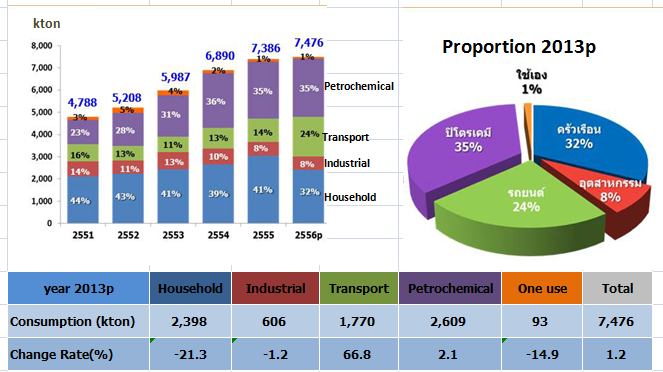2013 Energy Consumption grows by 1.2 %

Overall, Thailand’s energy consumption in 2013 continues to grow by 1.2% but in comparison with last year, the total import value drops. It is also projected that the overall energy consumption of 2014 would surge by 2.5%.
Compared with 2012, the total primary energy consumption in 2013 was equal to 2 million barrels of oil equivalent per day, increasing by 1.2%. Natural gas shared the largest consumption, accounting for 46%, equivalent to about 917,015 barrels of oil equivalent per day with 3.2% increase. Second was oil consumption, accounting for 36%, equivalent to approximately 727,559 barrels of oil equivalent per day with 2.6% rise. This was followed by lignite/coal consumption which contributed to 16%, equivalent to around 313,320 barrels of oil equivalent per day with 4.4% drop. The import of hydropower accounted for 2%, equivalent to 46,635 barrels of oil equivalent per day, dropping by 15.7%.
For petroleum products, the consumption in the gasoline category reached 22.4 million liters per day. Of the total gasoline consumption, gasohol was used 20.7 million liters per day, surging from 12.2 liters per day in 2012. This was due to the abolishment of octane-91 gasoline sale in April 2013. Compared with 2012, the consumption of octane-95 gasoline rose from 0.12 million liters per day to 1.70 million liters per day in 2013, while the consumption of diesel rose from 56.2 million liters per day in 2012 to 57.2 million liters per day in 2013.
The total consumption of liquefied petroleum gas (LPG) was equal to 7.47 million tons, rising from 7.38 million tons in 2012. The LPG consumption in petrochemical industry rose by 2.1%, while household consumption of LPG dwindled by 21.3%. The largest increase was in transportation sector with 66.8% growth in consumption. This was because of the upward adjustment of the cooking gas price in September 2013 and the strict measures to suppress illegal sale of LPG.
On average, 4,602 cubic feet of natural gas was used per day, with 1.5% increase. All sectors increased their consumption except for the gas separation plants which consumed less by 2.6%. Natural gas consumption in power generation, industrial sector and vehicle sector rose by 2.1%, 1.1% and 10.4%, respectively.
The total usage of lignite was 18.6 million tons, rising by 1.8%. 83% of lignite consumption was for power generation while the industrial sector increased their lignite consumption by 17%. The total import of lignite reached 17 million tons, down by 7.5%. 54% of imported lignite was used in industrial sector, while independent power producer (IPP) and small power producer (SPP) consumed 33% and 13% of imported lignite, respectively.
The proportion of renewable energy consumption stood at 10.9% or 8,211 KTOE (1,000 tons of crude oil equivalent) out of final energy consumption at 75,214 KTOE. 3,503.52 megawatt (MW) of electricity was produced from renewable energy with wind energy accounting for 222.71 MW, solar energy for 635.48 MW, small hydropower for 104.77 MW, biomass for 2,230.05 MW, biogas for 262.73 MW, wastes for 47.48 MW and new form of energy generation for 0.3 MW.
Heat generation from renewable energy accounted for 5,335.50 KTOE. 4.50 KTOE were from solar energy, 4,769 KTOE from biomass, 85 KTOE from wastes. Meanwhile, the production of bio-fuel was at 5.31 million liters per day, with ethanol and biodiesel produced 2.53 and 2.78 million liters per day, respectively.
The total installed capacity was at 33,681 MW, with 3.32% increase. The gross peak load was at 26,598 MW, surging by 1.8%. The amount of power generation was 179,201 million units, rising by 1.3% while the electricity consumption was 165,560 million units, increasing by 2.3%.
The value of energy consumption in 2013 was 2.13 trillion baht, with 0.9% increase. Petroleum products accounted for 1,327,636 million baht, electricity for 541,974 million baht, natural gas for 121,147 baht, lignite/coal for 25,315 million baht and renewable energy for 118,469 million baht.
In 2013, the value of energy import was at 1.42 trillion baht, dropping by 2%. Crude oil stood for 1,073,000 million baht, the combination of natural gas and LPG for 146,944 million baht, petroleum products for 134,306 million baht, coal for 39,733 million baht and electricity for 20,168 million baht.
The value of energy export in 2013 was at 357,896 million baht, reducing by 10.8%. Out of this, the export value of petroleum products was 322,621 million baht, and the export of crude oil and electricity was equivalent to 30,927 and 4,348 million baht, respectively.
There was also petroleum from domestic sources and from Thailand-Malaysia joint development areas. Under this category, 1.374 trillion cubic feet of natural gas were produced. These sources also yielded 88.7 million barrels of liquefied gas and crude oil. As of the end of 2012, the amount of verifiable petroleum reserve including natural gas, condensate and crude oil was 2,700 million barrels per crude oil per day.
For the trend of energy consumption in 2014, it was expected that the demand for primary energy consumption would be 2,055 KBD, rising from 2013 by 2.5%. The demand for oil consumption would increase by 1.5%. The demand for gasoline would rise by 0.6%, diesel by 1.6%, airplane fuel by 5%, and natural gas by 4%.The consumption of hydropower and imported electricity would surge by 7%, while the need for coal/lignite would be close to that of 2013. Power generation would rise by 4.1%. The household demand for LPG was expected to drop by 4.7%. However, the LPG demand for industrial sector, petrochemical industry and vehicle consumption was likely to rise by 0.4%, 2.9% and 12.9%, respectively.
| Attachment | Size |
|---|---|
| 123.89 KB |


